Deep Water Ports as a Trigger for Ongoing Land Use Conflicts? The Case of Jade Weser Port in Germany
Abstract
1. Introduction
- What are the main drivers for generating demand for land use change and land use conflicts, especially along coastlines with sensitive areas?
- What are the main institutional settings, especially those that focus on the interrelations between transport and the land use cycle?
2. Theoretical Background
3. Case Study Approach, Hypotheses, and Methods for Analysis
3.1. Case Study Context
3.2. Hypotheses
3.3. Material and Methods
3.3.1. Document Analysis
3.3.2. GIS Analysis
3.3.3. Interviews
3.3.4. Site Observations
4. Results
4.1. Demand for Land on Seaside and Landside Areas
4.2. Planning Processes and Feedback Loops
5. Discussion
6. Conclusions and Outlook
Author Contributions
Funding
Data Availability Statement
Conflicts of Interest
References
- Micheli, F.; Niccolini, F. Achieving Success under Pressure in the Conservation of Intensely Used Coastal Areas. Ecol. Soc. 2013, 18, 19. [Google Scholar] [CrossRef]
- Felsenstein, D.; Lichter, M.; Ashbel, E. Coastal congestion: Simulating port expansion and land use change under zero-sum conditions. Ocean Coast. Manag. 2014, 101, 89–101. [Google Scholar] [CrossRef]
- Small, C.; Nicholls, R.J. A global analysis of human settlement in coastal zones. J. Coast. Res. 2003, 19, 584–599. [Google Scholar]
- Neumann, B.; Ott, K.; Kenchington, R. Strong sustainability in coastal areas: A conceptual interpretation of SDG 14. Sust. Sci. 2017, 12, 1019–1035. [Google Scholar] [CrossRef]
- Bello, F.G.; Lovelock, B.; Carr, N. Constraints of community participation in protected area-based tourism planning: The case of Malawi. J. Ecotourism 2017, 16, 131–151. [Google Scholar] [CrossRef]
- Plieninger, T.; Draux, H.; Fagerholm, N.; Bieling, C.; Bürgi, M.; Kizos, T.; Kuemmerle, T.; Primdahl, J.; Verburg, P.H. The driving forces of landscape change in Europe: A systematic review of the evidence. Land Use Policy 2016, 57, 204–214. [Google Scholar] [CrossRef]
- Dunford, M.; Yeung, G. Port–Industrial Complexes and Regional Development. In International Encyclopedia of Human Geography, 2nd ed.; Kobayashi, A., Ed.; Elsevier: Oxford, UK, 2020; pp. 271–280. ISBN 978-0-08-102296-2. [Google Scholar]
- Global Land Program. Telecoupling of Land Use Systems. 2025. Available online: https://glp.earth/our-science/themes/telecoupling-land-use-systems (accessed on 14 April 2025).
- Gee, K.; Kannen, A.; Glaeser, B.; Sterr, H. National ICZM strategies in Germany: A spatial planning approach. In Managing the Baltic Sea; Schernewski, G., Loser, N., Eds.; Coastline Reports; EUCC: Warnemünde, Germany, 2004; Volume 2, pp. 23–33. [Google Scholar]
- Kannen, A.; Burkhard, B. Integrated Assessment of Coastal and Marine Changes Using the Example of Offshore Wind Farms: The Coastal Futures Approach. GAIA—Ecol. Perspect. Sci. Soc. 2009, 18, 229–238. [Google Scholar] [CrossRef]
- Von Der Dunk, A.; Grêt-Regamey, A.; Dalang, T.; Hersperger, A.M. Defining a typology of peri-urban land-use conflicts—A case study from Switzerland. Landsc. Urban Plan. 2011, 101, 149–156. [Google Scholar] [CrossRef]
- Alterman, R.; Pellach, C. Regulating Coastal Zones: International Perspectives on Land Management Instruments; Taylor & Francis: Abingdon, UK, 2021. [Google Scholar]
- Jouili, T.A.; Allouche, M.A. Impacts of seaport investment on the economic growth. Promet-Traffic Transp. 2016, 28, 365–370. [Google Scholar] [CrossRef]
- Notteboom, T. Economic Analysis of the European Seaport System; Report for the European Sea Ports Organisation; ITMMA, University of Antwerp: Antwerp, Blegium, 2009. [Google Scholar]
- Kasraian, D.; Maat, K.; Stead, D.; Van Wee, B. Long-term impacts of transport infrastructure networks on land-use change: An international review of empirical studies. Transp. Rev. 2016, 36, 772–792. [Google Scholar] [CrossRef]
- Liu, J.; Herzberger, A.; Kapsar, K.; Carlson, A.K.; Connor, T. What is telecoupling? In Telecoupling: Exploring Land-Use Change in a Globalised World; Palgrave Macmillan: Cham, Switzerland, 2019; pp. 19–48. [Google Scholar]
- Liu, J.; Dietz, T.; Carpenter, S.R.; Taylor, W.W.; Alberti, M.; Deadman, P.; Redman, C.; Pell, A.; Folke, C.; Ouyang, Z. Coupled human and natural systems: The evolution and applications of an integrated framework: This article belongs to Ambio’s 50th Anniversary Collection. Theme: Anthropocene. Ambio 2021, 50, 1778–1783. [Google Scholar] [CrossRef] [PubMed]
- Franzke, C.L.; Ciullo, A.; Gilmore, E.A.; Matias, D.M.; Nagabhatla, N.; Orlov, A.; Paterson, S.K.; Scheffran, J.; Sillmann, J. Perspectives on tipping points in integrated models of the natural and human Earth system: Cascading effects and telecoupling. Environ. Res. Lett. 2022, 17, 015004. [Google Scholar] [CrossRef]
- Kapsar, K.; Frans, V.F.; Brigham, L.W.; Liu, J. The metacoupled Arctic: Human–nature interactions across local to global scales as drivers of sustainability. Ambio 2022, 51, 2061–2078. [Google Scholar] [CrossRef] [PubMed]
- Wegener, M.; Fuerst, F. Land-Use Transport Interaction: State of the Art. SSRN J. 2004, 1434678. [Google Scholar] [CrossRef]
- Sikor, T.; Auld, G.; Bebbington, A.J.; Benjaminsen, T.A.; Gentry, B.S.; Hunsberger, C.; Izac, A.-M.; Margulis, M.E.; Plieninger, T.; Schroeder, H. Global land governance: From territory to flow? Curr. Opin. Environ. Sustain. 2013, 5, 522–527. [Google Scholar] [CrossRef]
- Cotta, B.; Coenen, J.; Challies, E.; Newig, J.; Lenschow, A.; Schilling-Vacaflor, A. Environmental governance in globally telecoupled systems: Mapping the terrain towards an integrated research agenda. Earth Syst. Gov. 2022, 13, 100142. [Google Scholar] [CrossRef]
- Boillat, S.; Gerber, J.-D.; Oberlack, C.; Zaehringer, J.G.; Ifejika Speranza, C.; Rist, S. Distant interactions, power, and environmental justice in protected area governance: A telecoupling perspective. Sustainability 2018, 10, 3954. [Google Scholar] [CrossRef]
- Bertolini, L. From “streets for traffic” to “streets for people”: Can street experiments transform urban mobility? Transp. Rev. 2020, 40, 734–753. [Google Scholar] [CrossRef]
- Verburg, P.H.; Crossman, N.; Ellis, E.C.; Heinimann, A.; Hostert, P.; Mertz, O.; Nagendra, H.; Sikor, T.; Erb, K.-H.; Golubiewski, N. Land system science and sustainable development of the earth system: A global land project perspective. Anthropocene 2015, 12, 29–41. [Google Scholar] [CrossRef]
- Müller, D.; Munroe, D.K. Current and future challenges in land-use science. J. Land Use Sci. 2014, 9, 133–142. [Google Scholar] [CrossRef]
- Verburg, P.H.; Erb, K.-H.; Mertz, O.; Espindola, G. Land System Science: Between global challenges and local realities. Curr. Opin. Environ. Sustain. 2013, 5, 433–437. [Google Scholar] [CrossRef]
- Lee, J.K. Transport infrastructure investment, accessibility change and firm productivity: Evidence from the Seoul region. J. Transp. Geogr. 2021, 96, 103182. [Google Scholar] [CrossRef]
- McCann, P.; Shefer, D. Location, agglomeration and infrastructure. Pap. Reg. Sci. 2004, 83, 177–196. [Google Scholar] [CrossRef]
- Banister, D.; Berechman, Y. Transport investment and the promotion of economic growth. J. Transp. Geogr. 2001, 9, 209–218. [Google Scholar] [CrossRef]
- Spiekermann, K.; Wegener, M. European regional accessibility and the spatial impacts of transport energy price increases. In The accessibility and attractiveness of rural and landlocked areas: Sustainable transport and services of general interest. Eur. Spat. Plan. Landsc. 2007, 87, 49–58. [Google Scholar]
- Bensassi, S.; Márquez-Ramos, L.; Martínez-Zarzoso, I.; Suárez-Burguet, C. Relationship between logistics infrastructure and trade: Evidence from Spanish regional exports. Transp. Res. Part A Policy Pract. 2015, 72, 47–61. [Google Scholar] [CrossRef]
- Notteboom, T.; Rodrigue, J.-P. Containerisation, box logistics and global supply chains: The integration of ports and liner shipping networks. Marit. Econ. Logist. 2008, 10, 152–174. [Google Scholar] [CrossRef]
- Kasraian, D.; Maat, K.; Van Wee, B. The impact of urban proximity, transport accessibility and policy on urban growth: A longitudinal analysis over five decades. Environ. Plan. B Urban Anal. City Sci. 2019, 46, 1000–1017. [Google Scholar] [CrossRef]
- Blotevogel, H.H.; Danielzyk, R.; Münter, A. Spatial planning in Germany: Institutional inertia and new challenges. In Spatial Planning Systems and Practices in Europe; Routledge: Abingdon, UK, 2014; pp. 83–108. [Google Scholar]
- Savini, F. The governability of national spatial planning: Light instruments and logics of governmental action in strategic urban development. Urban Stud. 2013, 50, 1592–1607. [Google Scholar] [CrossRef]
- de Roo, G.; Silva, E.A. (Eds.) A planner’s Encounter with complexity. In New Directions in Planning Theory; Routledge: London, UK; New York, NY, USA, 2016; ISBN 978-1-315-56508-8. [Google Scholar] [CrossRef]
- Global Land Program. Land Governance. 2025. Available online: https://glp.earth/our-science/themes/land-governance (accessed on 16 April 2025).
- Lackowska, M.; Zimmermann, K. New forms of territorial governance in metropolitan regions? A Polish–German comparison. Eur. Urban Reg. Stud. 2011, 18, 156–169. [Google Scholar] [CrossRef]
- Chigbu, U.E.; Kalashyan, V. Yerevan State University Land-Use Planning and Public Administration in Bavaria, Germany: Towards A Public Administration Approach to Land-Use Planning. GLL 2015, 1, 7–17. [Google Scholar] [CrossRef]
- Müller, D.; Haberl, H.; Bartels, L.E.; Baumann, M.; Beckert, M.; Levers, C.; Schierhorn, F.; Zscheischler, J.; Havlik, P.; Hostert, P. Competition for land-based ecosystem services: Trade-offs and synergies. In Land Use Competition: Ecological, Economic and Social Perspectives; Springer: Cham, Switzerland, 2016; pp. 127–147. [Google Scholar]
- Farthing, S. Research Design in Urban Planning: A Student’s Guide; Sage: Thousand Oaks, CA, USA, 2015. [Google Scholar]
- Susman, R.; Gütte, A.; Weith, T. Drivers of Land Use Conflicts in Infrastructural Mega Projects in Coastal Areas: A Case Study of Patimban Seaport, Indonesia. Land 2021, 10, 615. [Google Scholar] [CrossRef]
- Stadt Wilhelmshaven Stadt. Wilhelmshaven: Daten und Fakten. 2023. Available online: https://www.wilhelmshaven.de/Wirtschaft/Fakten.php (accessed on 25 July 2025).
- Jadeweserport Realisierungsgesellschaft. The Construction of JadeWeserPort A Deepwater Container Terminal in Wilhelmshaven. 2008. Available online: https://hdl.handle.net/20.500.11970/101621 (accessed on 18 November 2020).
- Götschenberg, A.; Kahlfeld, A. The Jade. 2008. Available online: https://hdl.handle.net/20.500.11970/101610 (accessed on 6 March 2021).
- Jade Weser Port. Jade Weser Port Wilhelmshaven. 2022. Available online: https://www.jadeweserport.de/ (accessed on 18 November 2020).
- Reise, K. Wann bewegt sich die Nordseeküste. Natur und Landschaft 2014, 89, 534–539. [Google Scholar]
- The Federal State of Lower Saxony. Available online: https://www.ml.niedersachsen.de/startseite/themen/raumordnung_landesplanung/landes_raumordnungsprogramm/neubekanntmachung-der-lrop-verordnung-2017-158596.html (accessed on 9 February 2020).
- Interview 1; (Oldenburg University, Oldenburg, Germany). Personal communication, 2020.
- Dalgetty, R.; Miller, C.B.; Dombrowski, S.U. Examining the theory-effectiveness hypothesis: A systematic review of systematic reviews. Br. J. Health Psychol. 2019, 24, 334–356. [Google Scholar] [CrossRef]
- Swain, M. The output hypothesis: Theory and research. In Handbook of Research in Second Language Teaching and Learning; Lawrence Erlbaum Associates; Routledge: Abingdon, UK, 2005. [Google Scholar]
- McKinnon, A.; Browne, M.; Whiteing, A.; Piecyk, M. (Eds.) Green Logistics: Improving the Environmental Sustainability of Logistics; Kogan Page Publishers: London, UK, 2015. [Google Scholar]
- Mudronja, G.; Jugović, A.; Škalamera-Alilović, D. Seaports and economic growth: Panel data analysis of EU port regions. J. Mar. Sci. Eng. 2020, 8, 1017. [Google Scholar] [CrossRef]
- Lichter, M.; Felsenstein, D. Coastal Communities under Threat: Comparing Property and Social Exposure. Geogr. Res. Forum 2015, 19, 40–58. [Google Scholar]
- Masselink, G. Coastal Environments and Global Change; Wiley: Chichester, UK, 2014; ISBN 978-0-470-65660-0. [Google Scholar]
- Straatemeier, T.; Bertolini, L. How can planning for accessibility lead to more integrated transport and land-use strategies? Two examples from the Netherlands. Eur. Plan. Stud. 2020, 28, 1713–1734. [Google Scholar] [CrossRef]
- Busch, M. Land use conflicts in the coastal zone: The potential of informal conflict resolution along the case of JadeWeserPort in Germany. In Proceedings of the Littoral 2010—Adapting to Global Change at the Coast: Leadership, Innovation, and Investment, London, UK, 21–23 September 2010; EDP Sciences: London, UK, 2011; p. 10002. [Google Scholar] [CrossRef][Green Version]
- Henger, R.; Bizer, K. Tradable planning permits for land-use control in Germany. Land Use Policy 2010, 27, 843–852. [Google Scholar] [CrossRef]
- Mann, C.; Jeanneaux, P. Two Approaches for Understanding Land-Use Conflict to Improve Rural Planning and Management. J. Rural Community Dev. 2009, 4, 1–24. [Google Scholar]
- Savini, F.; Majoor, S.; Salet, W. Dilemmas of planning: Intervention, regulation, and investment. Plan. Theory 2015, 14, 296–315. [Google Scholar] [CrossRef]
- Lee, J.; Tian, L.; Erickson, L.J.; Kulikowski, T.D. Analyzing growth-management policies with geographical information systems. Environ. Plan. B Plan. Des. 1998, 25, 865–879. [Google Scholar] [CrossRef]
- Pijanowski, B.C.; Brown, D.G.; Shellito, B.A.; Manik, G.A. Using neural networks and GIS to forecast land use changes: A Land Transformation Model. Comput. Environ. Urban Syst. 2002, 26, 553–575. [Google Scholar] [CrossRef]
- Hintjens, J. Cooperation Between Sea Ports Concerning Hinterland Transport; University of Antwerp: Antwerp, Belgium, 2019; ISBN 90-5728-634-3. [Google Scholar]
- Wadden Sea National Park. Wadden Sea National Park of Lower Saxony. 2020. Available online: https://www.nationalpark-wattenmeer.de/nds/ (accessed on 21 March 2020).
- Interview 2; (Federal Waterways Engineering and Research Institute, Hamburg, Germany). Personal communication, 2020.
- Wegener, M. Land-use transport interaction models. In Handbook of Regional Science; Springer: Berlin/Heidelberg, Germany, 2021; pp. 229–246. [Google Scholar]
- de Jong, L.; De Bruin, S.; Knoop, J.; van Vliet, J. Understanding land-use change conflict: A systematic review of case studies. J. Land Use Sci. 2021, 16, 223–239. [Google Scholar] [CrossRef]
- Steinhäußer, R.; Siebert, R.; Steinführer, A.; Hellmich, M. National and regional land-use conflicts in Germany from the perspective of stakeholders. Land Use Policy 2015, 49, 183–194. [Google Scholar] [CrossRef]
- Živojinović, I.; Elomina, J.; Pülzl, H.; Calanasan, K.; Dabić, I.; Ólafsdóttir, R.; Siikavuopio, S.; Iversen, A.; Robertsen, R.; Bjerke, J. Exploring land use conflicts arising from economic activities and their impacts on local communities in the European Arctic. J. Land Use Sci. 2024, 19, 186–210. [Google Scholar] [CrossRef]
- Kirschke, D.; Häger, A.; Schmid, J.C. New trends and drivers for agricultural land use in Germany. Sustain. Land Manag. A Eur. Context 2021, 8, 39–61. [Google Scholar]
- Klaipeda Seaport. Klaipeda Report. 2024. Available online: https://portofklaipeda.lt/en/port/about-the-port-of-klaipeda/ (accessed on 8 September 2024).
- Burskyte, V.; Belous, O. Klaipeda seaport key sustainability points. In Proceedings of the 2012 IEEE/OES Baltic International Symposium (BALTIC), Klaipeda, Lithuania, 8–10 May 2012; pp. 1–8. [Google Scholar]
- Van Assche, K.; Beunen, R.; Oliveira, E. Spatial planning and place branding: Rethinking relations and synergies. Eur. Plan. Stud. 2020, 28, 1274–1290. [Google Scholar] [CrossRef]
- Tian, H.; Lindenmayer, D.B.; Wong, G.T.; Mao, Z.; Huang, Y.; Xue, X. A methodological framework for coastal development assessment: A case study of Fujian Province, China. Sci. Total Environ. 2018, 615, 572–580. [Google Scholar] [CrossRef]
- Global Land Program. Land Management System. 2025. Available online: https://glp.earth/our-science/themes/land-management-systems (accessed on 14 April 2025).
- Veldkamp, E.; Schmidt, M.; Powers, J.S.; Corre, M.D. Deforestation and reforestation impacts on soils in the tropics. Nat. Rev. Earth Environ. 2020, 1, 590–605. [Google Scholar] [CrossRef]
- Leal Filho, W.; Mandel, M.; Al-Amin, A.Q.; Feher, A.; Chiappetta Jabbour, C.J. An assessment of the causes and consequences of agricultural land abandonment in Europe. Int. J. Sustain. Dev. World Ecol. 2017, 24, 554–560. [Google Scholar] [CrossRef]
- Farwig, N.; Sprenger, P.P.; Baur, B.; Böhning-Gaese, K.; Brandt, A.; Eisenhauer, N.; Ellwanger, G.; Hochkirch, A.; Karamanlidis, A.A.; Mehring, M.; et al. Identifying Major Factors for Success and Failure of Conservation Programs in Europe. Environ. Manag. 2025, 75, 425–443. [Google Scholar] [CrossRef] [PubMed]
- Hoch, C. A pragmatic inquiry about planning and power. In Explorations in Planning Theory; Routledge: Abingdon, UK, 2017; pp. 30–44. [Google Scholar]
- Müller, F.; Bicking, S.; Ahrendt, K.; Bac, D.K.; Blindow, I.; Fürst, C.; Haase, P.; Kruse, M.; Kruse, T.; Ma, L. Assessing ecosystem service potentials to evaluate terrestrial, coastal and marine ecosystem types in Northern Germany—An expert-based matrix approach. Ecol. Indic. 2020, 112, 106116. [Google Scholar] [CrossRef]
- Connell, D.J. Theories of planning. In Land Use Planning and Policy in British Columbia; Pressbooks: Monteral, QC, Canada, 2023. [Google Scholar]
- Felsenstein, D.; Lichter, M. Land use change and management of coastal areas: Retrospect and prospect. Ocean Coast. Manag. 2014, 101, 123–125. [Google Scholar] [CrossRef]
- Friis, C.; Nielsen, J.Ø.; Otero, I.; Haberl, H.; Niewöhner, J.; Hostert, P. From teleconnection to telecoupling: Taking stock of an emerging framework in land system science. J. Land Use Sci. 2016, 11, 131–153. [Google Scholar] [CrossRef]
- Fürst, C. Upcoming challenges in land use science—an international perspective. In Sustainable Land Management in a European Context; Springer: Berlin/Heidelberg, Germany, 2021; p. 319. [Google Scholar]
- Carmona, M. The formal and informal tools of design governance. J. Urban Des. 2017, 22, 1–36. [Google Scholar] [CrossRef]
- Avelino, F. Theories of power and social change. Power contestations and their implications for research on social change and innovation. J. Political Power 2021, 14, 425–448. [Google Scholar] [CrossRef]
- Van Voorst, R. Formal and informal flood governance in Jakarta, Indonesia. Habitat Int. 2016, 52, 5–10. [Google Scholar] [CrossRef]
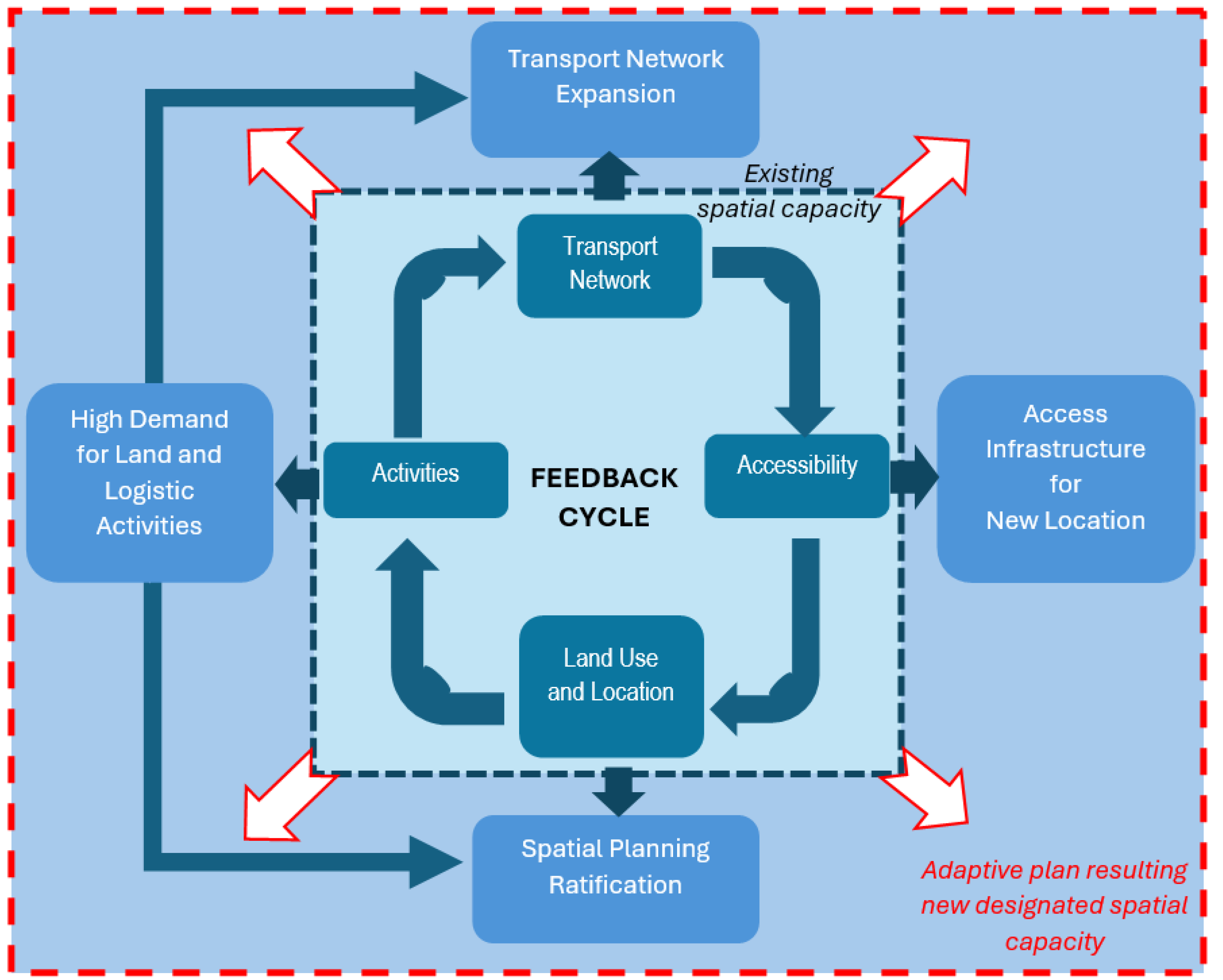
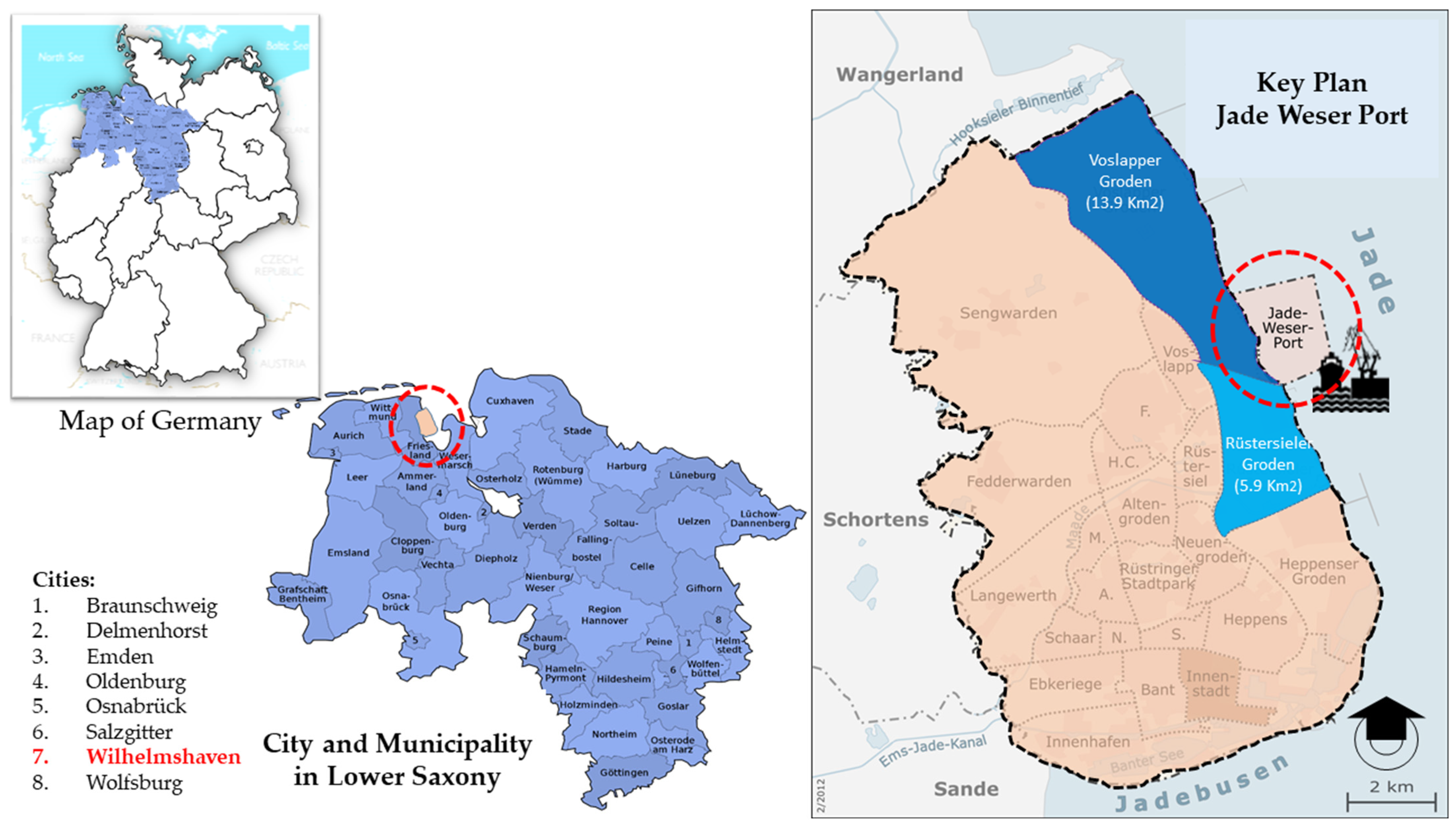
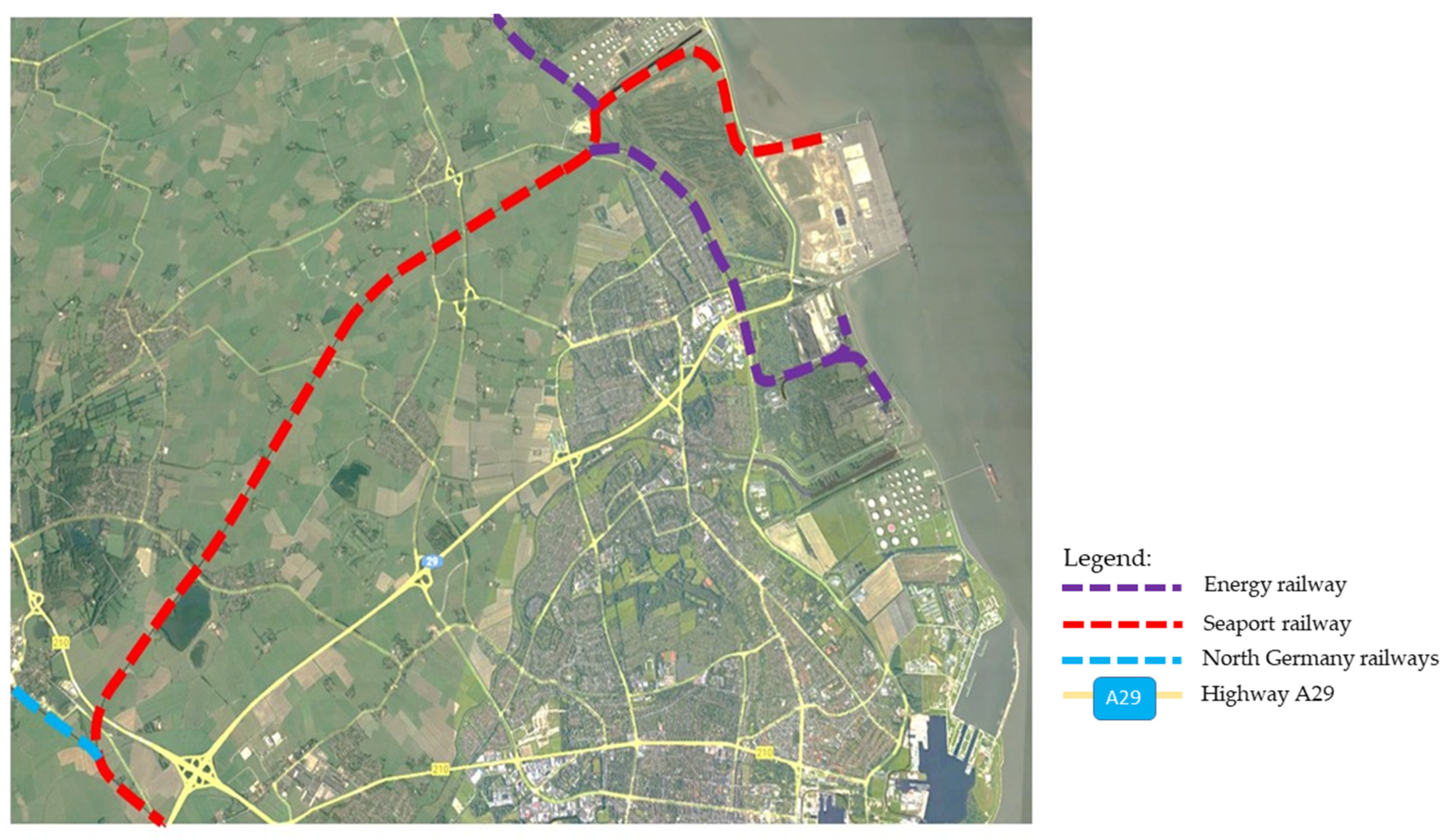


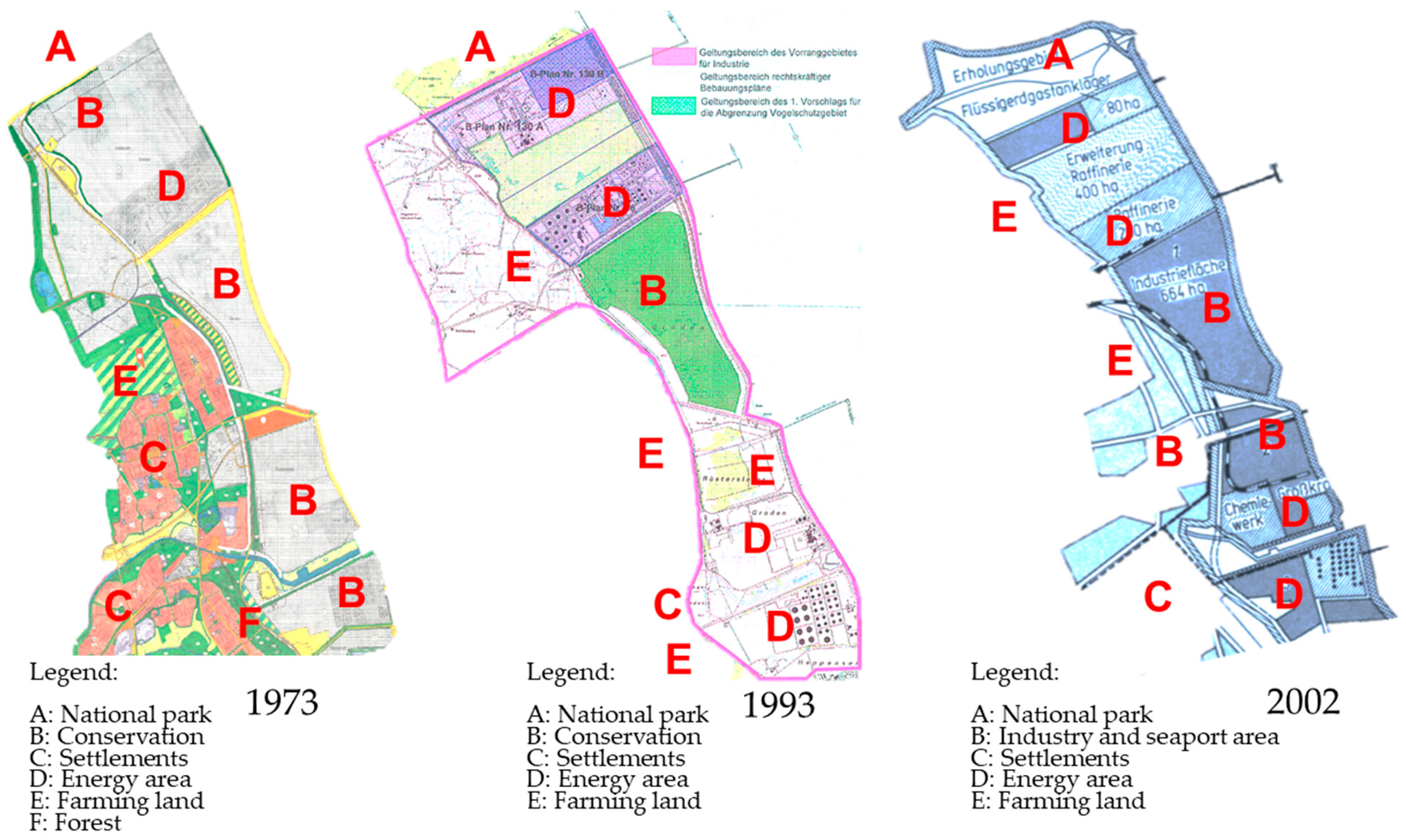
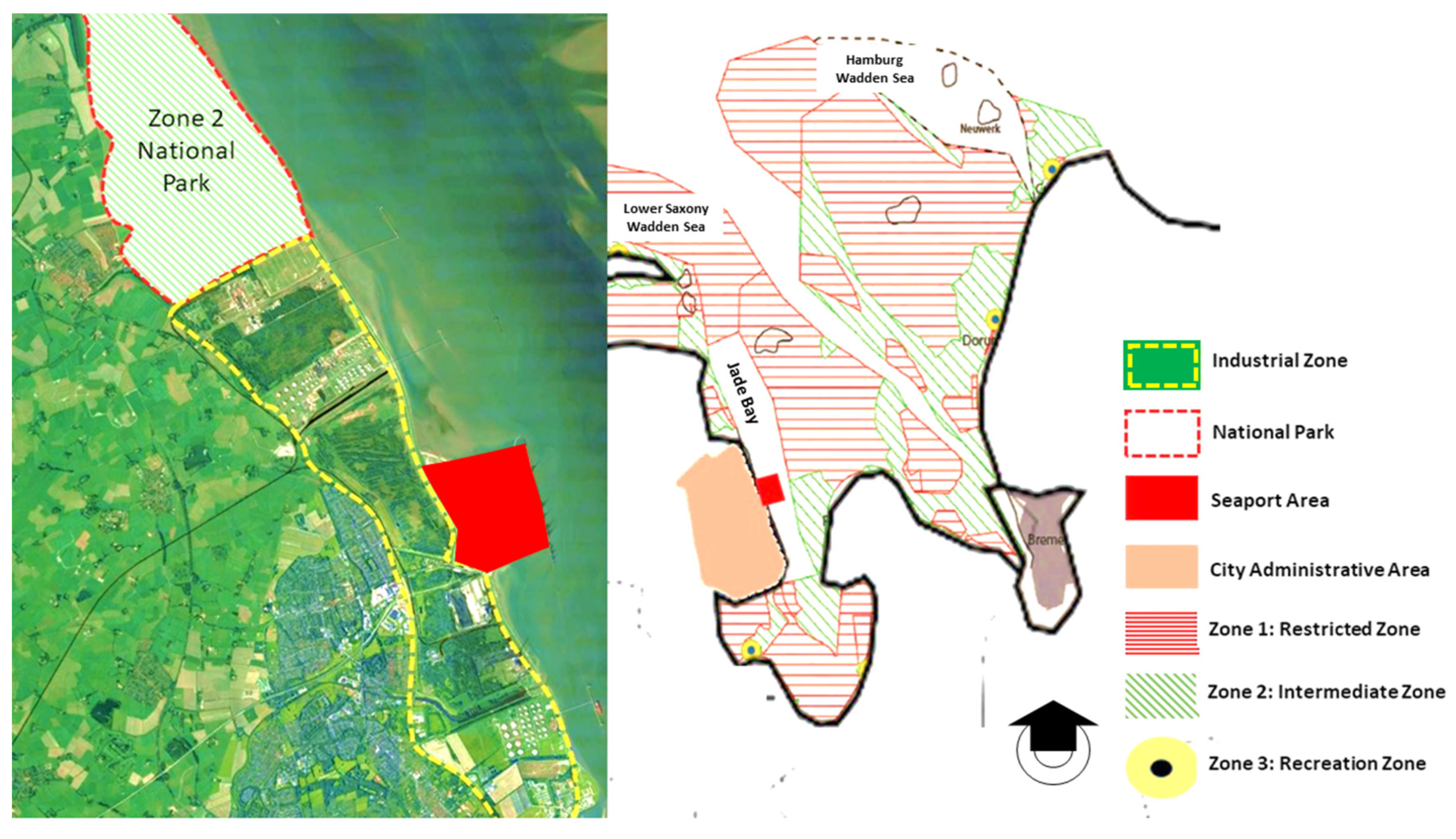
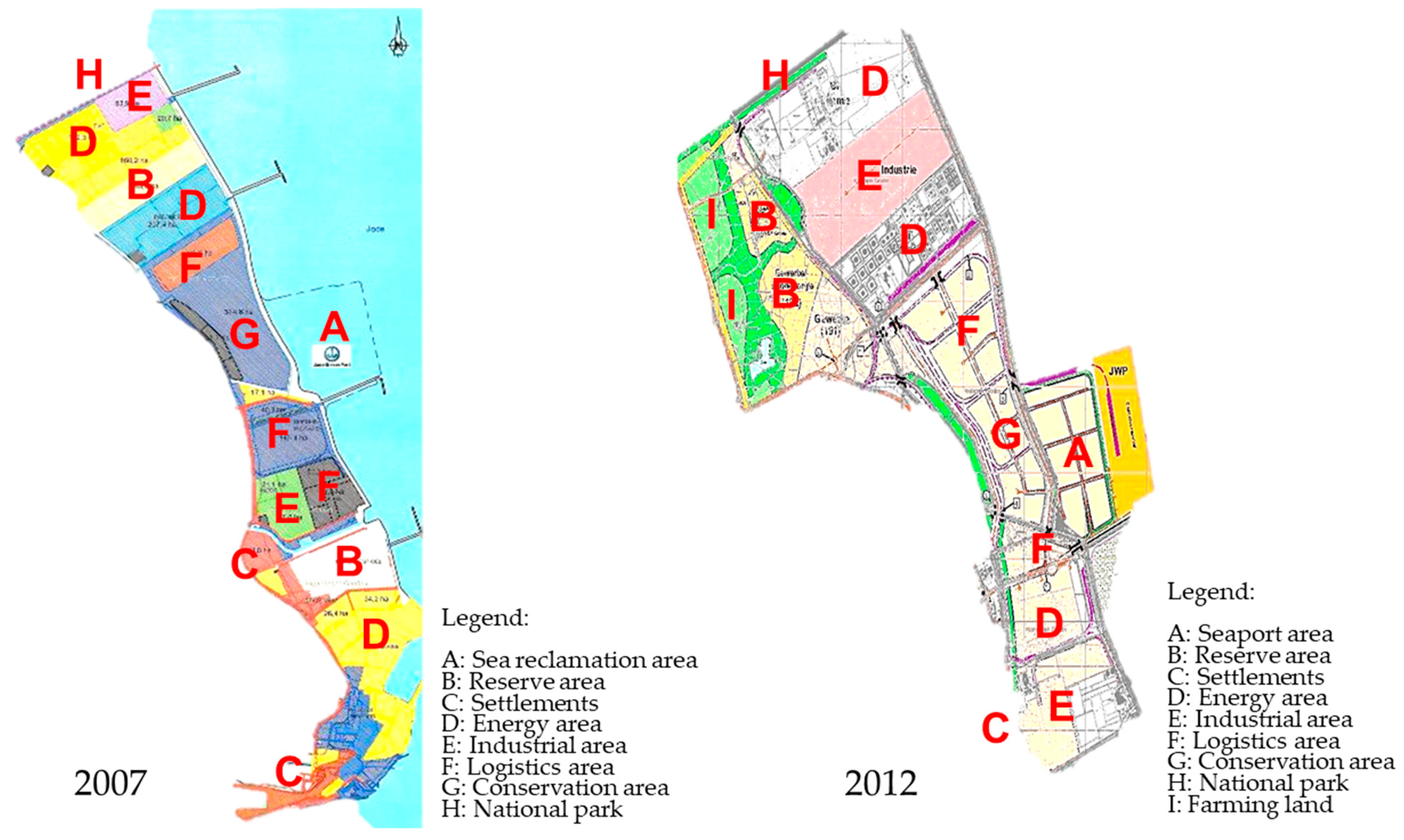


| Governmental Level | Planning Documents |
|---|---|
| National | Regulations about national parks |
| Regulations about ICZM | |
| Regulation for seaport development in Germany | |
| Federal | Regional plans and concepts (RROP) |
| City | Land use plan (Flächennutzungsplan) |
| Neighborhood | Master plan of Jade Weser Port |
| Real Land Use Changes | Fundamental Changes in Transportation Infrastructure | Changes in Nature Protection | Planning and Regulation | |
|---|---|---|---|---|
| Demand for land on the seaside and landside in sensitive areas | Agglomeration of new industrial areas and storage related to the seaport upon extension of the new transport network | Increase in demand for new transportation networks that connect the outer area and seaport, reaching sensitive areas | Sea reclamation is decided to limit demand on the seaside and protect existing coastal areas | Changes in the process of spatial plans and ratification toward investment-friendly planning |
| Planning process, feedback loops, and intervention | A new transport network follows a new industrial area and vice versa | New logistic infrastructure (expansion plan) versus the limit of spatial capacity | Ongoing and future impacts on the protected area | Adaptive and compromise-driven land use planning of future scenarios (anticipative plan) |
Disclaimer/Publisher’s Note: The statements, opinions and data contained in all publications are solely those of the individual author(s) and contributor(s) and not of MDPI and/or the editor(s). MDPI and/or the editor(s) disclaim responsibility for any injury to people or property resulting from any ideas, methods, instructions or products referred to in the content. |
© 2025 by the authors. Licensee MDPI, Basel, Switzerland. This article is an open access article distributed under the terms and conditions of the Creative Commons Attribution (CC BY) license (https://creativecommons.org/licenses/by/4.0/).
Share and Cite
Susman, R.; Weith, T. Deep Water Ports as a Trigger for Ongoing Land Use Conflicts? The Case of Jade Weser Port in Germany. Land 2025, 14, 2009. https://doi.org/10.3390/land14102009
Susman R, Weith T. Deep Water Ports as a Trigger for Ongoing Land Use Conflicts? The Case of Jade Weser Port in Germany. Land. 2025; 14(10):2009. https://doi.org/10.3390/land14102009
Chicago/Turabian StyleSusman, Roni, and Thomas Weith. 2025. "Deep Water Ports as a Trigger for Ongoing Land Use Conflicts? The Case of Jade Weser Port in Germany" Land 14, no. 10: 2009. https://doi.org/10.3390/land14102009
APA StyleSusman, R., & Weith, T. (2025). Deep Water Ports as a Trigger for Ongoing Land Use Conflicts? The Case of Jade Weser Port in Germany. Land, 14(10), 2009. https://doi.org/10.3390/land14102009







